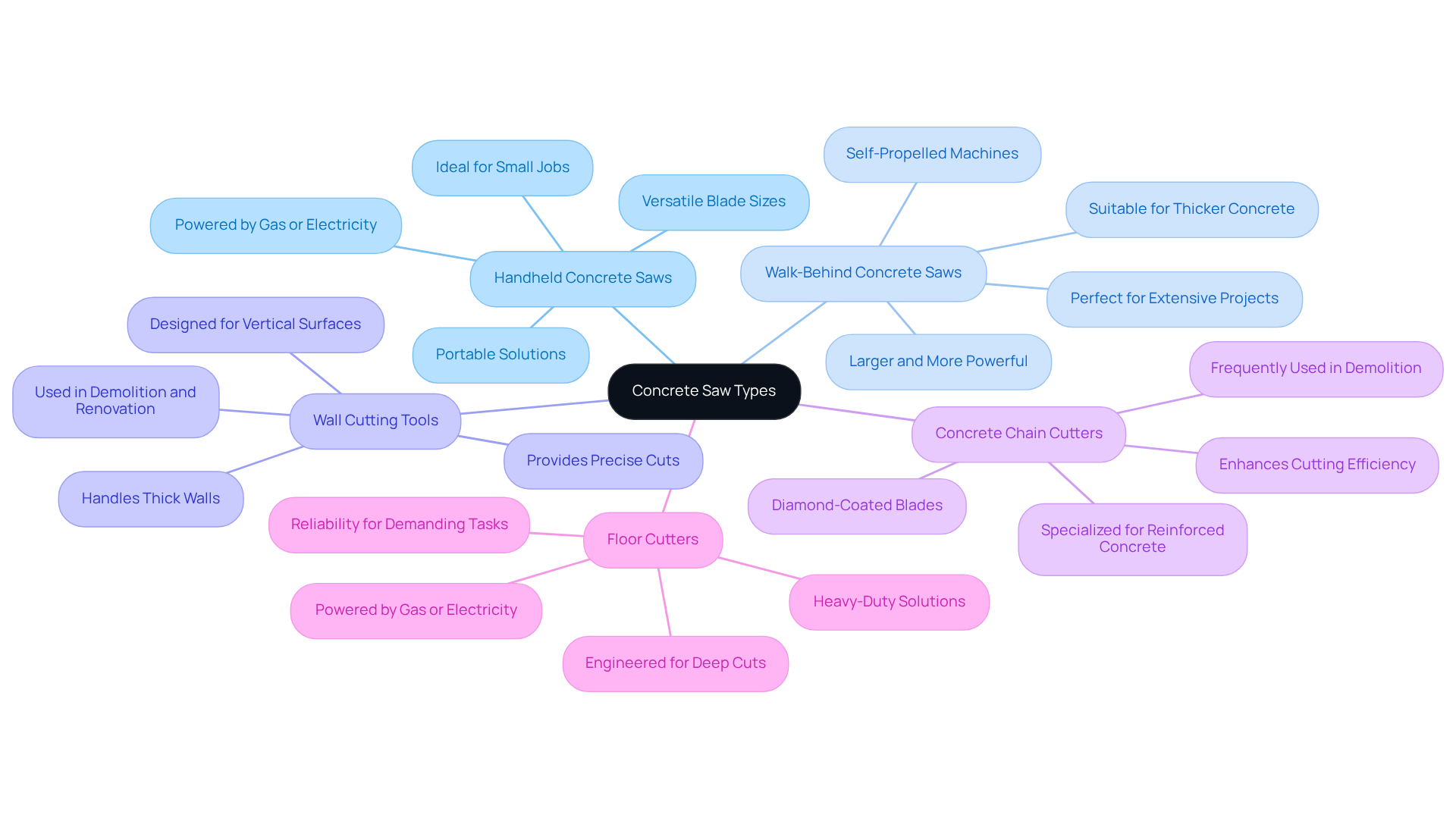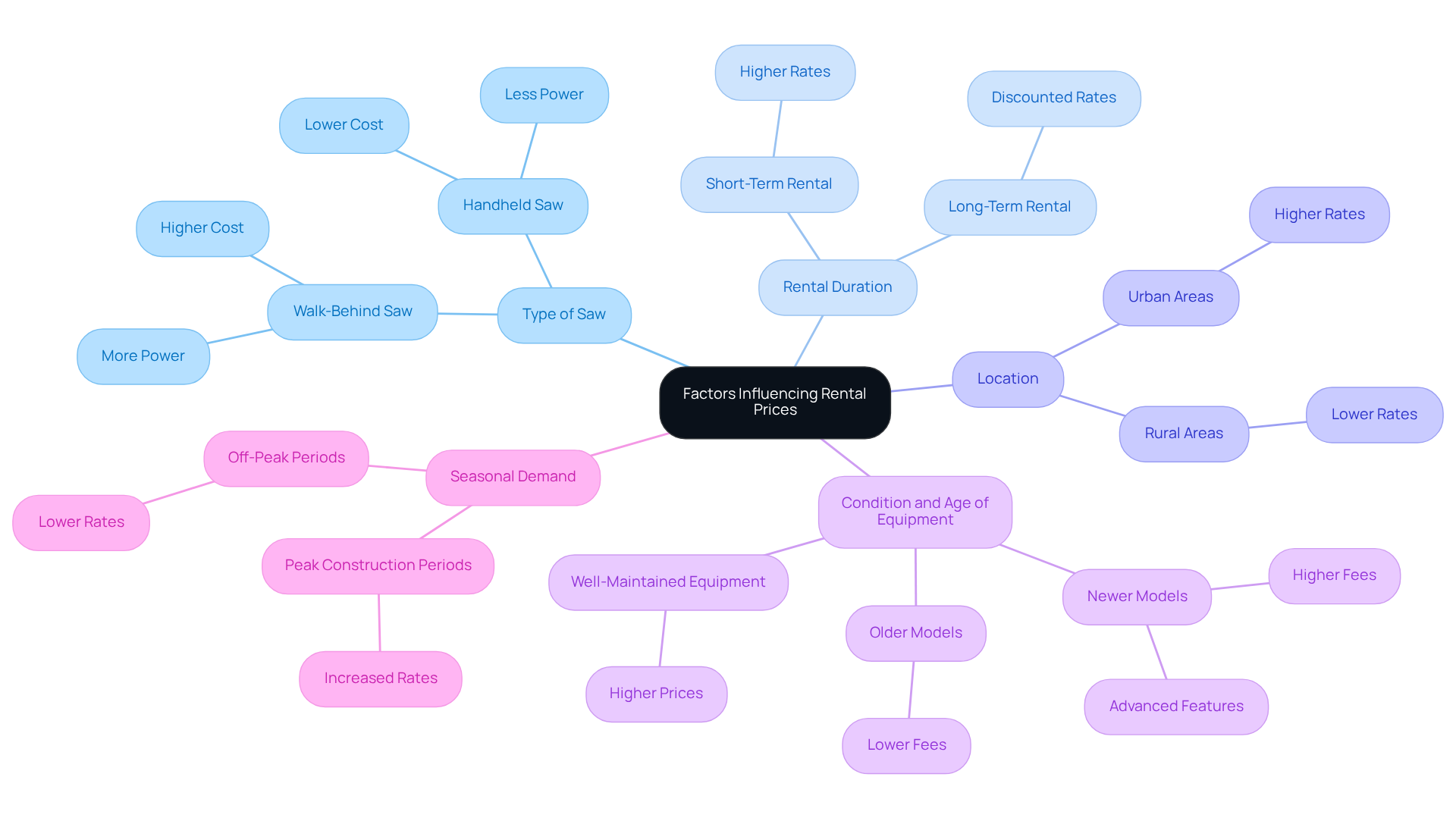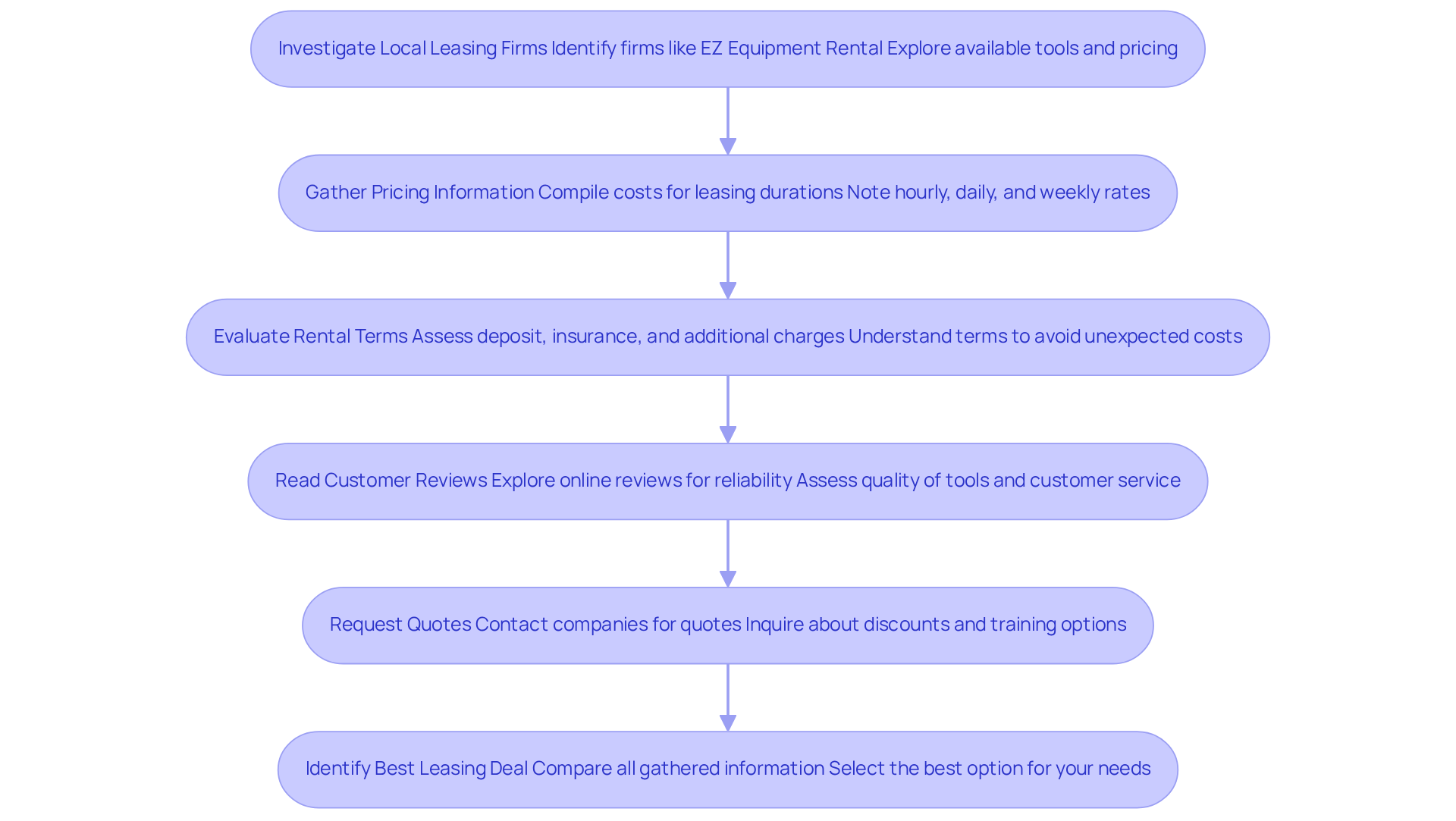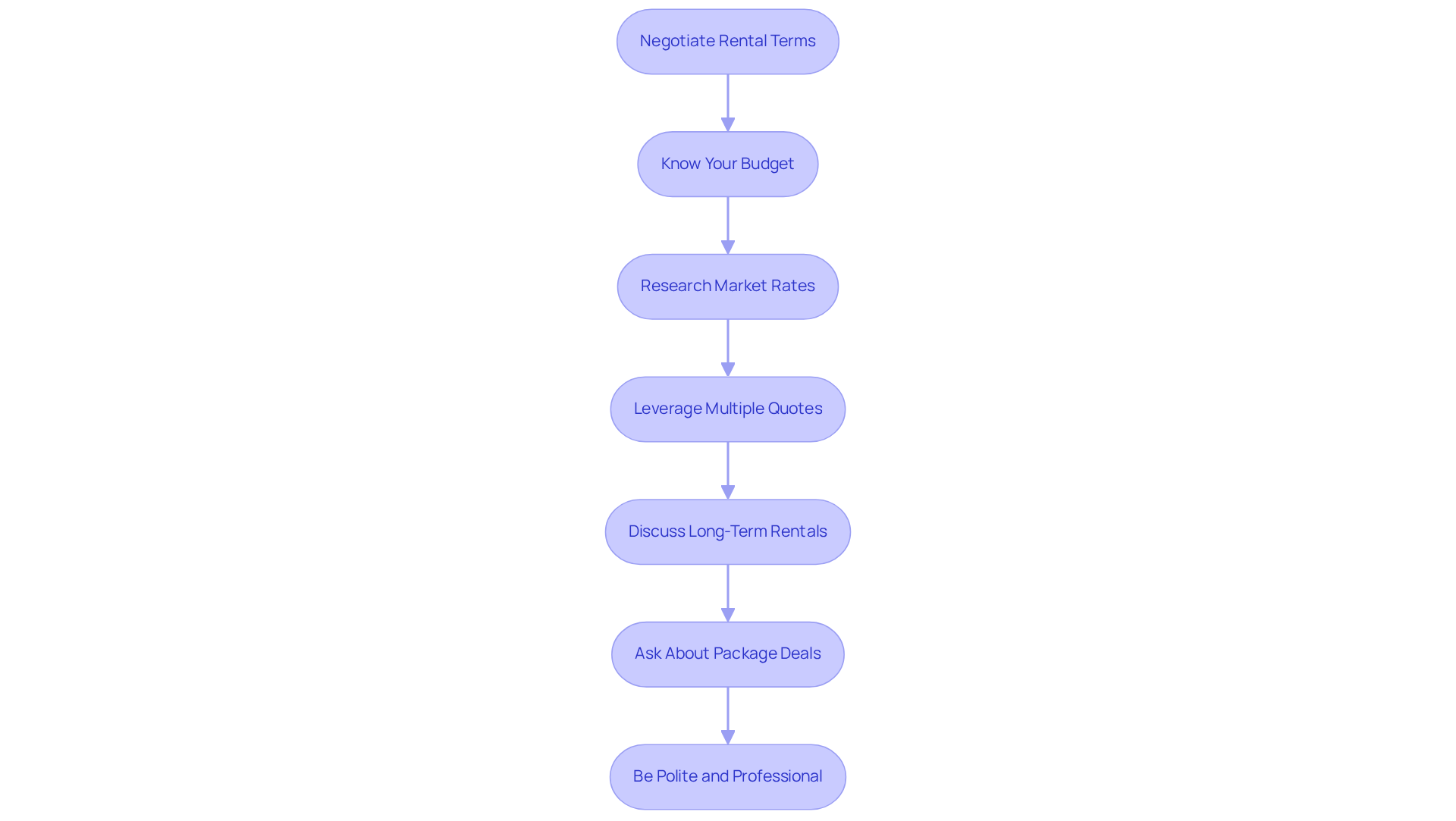Overview
This article serves as a comprehensive guide to mastering concrete saw rental prices. It outlines the various types of concrete saws available, the factors that influence rental costs, and effective strategies for comparing and negotiating rental options. Understanding the specific type of saw needed and its associated costs is crucial. Moreover, employing negotiation tactics—such as leveraging multiple quotes and discussing long-term rentals—can significantly impact overall rental expenses and enhance project budgeting.
Key Highlights:
- Concrete cutting tools come in various types, including handheld, walk-behind, wall cutting, concrete chain cutters, and floor cutters, each designed for specific applications.
- Handheld concrete saws are portable and suitable for small jobs, while walk-behind saws are larger and ideal for thicker concrete.
- Wall cutting tools are used for vertical surfaces, while concrete chain cutters are effective for reinforced concrete demolition.
- Factors influencing concrete saw rental prices include the type of saw, rental duration, location, equipment condition, and seasonal demand.
- Comparing rental options involves investigating local firms, gathering pricing information, evaluating rental terms, reading customer reviews, and requesting quotes.
- Negotiation strategies for better rental terms include knowing your budget, researching market rates, leveraging multiple quotes, discussing long-term rentals, asking about package deals, and maintaining a polite demeanour.
Introduction
Understanding the nuances of concrete saw rental prices is essential for effectively managing project budgets and outcomes. With a variety of saws available, ranging from handheld models ideal for small tasks to heavy-duty walk-behind saws suited for larger jobs, selecting the right tool is crucial for success.
However, the challenge extends beyond merely choosing appropriate equipment; it also involves navigating the complex factors that influence rental costs, such as:
- Duration
- Location
- Seasonal demand
In addition, renters must consider how to make informed decisions that maximize value while minimizing expenses.
Understand Concrete Saw Types and Features
Concrete cutting tools are available in various types, each meticulously designed for specific applications. Understanding these tools is essential for selecting the right equipment for your project needs, ensuring efficiency and effectiveness in your cutting tasks.
-
Handheld Concrete Saws are portable solutions ideal for small jobs, such as cutting slabs or pavers. Typically powered by gas or electricity, they can accommodate various blade sizes, making them versatile for different cutting tasks.
-
Walk-Behind Concrete Saws are larger, more powerful options suitable for cutting thicker concrete. These self-propelled machines can accommodate larger blades, making them perfect for extensive projects that require precision and strength.
-
Wall Cutting Tools are specifically designed for cutting vertical surfaces, often utilized in demolition and renovation projects. They provide precise cuts and can handle thick walls, ensuring that your work is efficient and accurate.
-
Concrete Chain Cutters are specialized tools designed for slicing through reinforced concrete, frequently employed in demolition work. Featuring diamond-coated blades, these tools enhance cutting efficiency, allowing for clean and effective cuts.
-
Floor Cutters represent heavy-duty solutions for cutting concrete floors. Powered by either gas or electricity, they are engineered for deep cuts, providing the reliability needed for demanding tasks.
By understanding these various types of concrete cutting tools, you can confidently choose the right saw for your specific project. This knowledge not only ensures that you achieve optimal results but also enhances your overall cutting experience. Take action now and equip yourself with the right tools for your next concrete project.

Evaluate Factors Influencing Rental Prices
Several factors significantly influence the concrete saw rental price.
-
Type of Saw: Different saws command varying rates based on their capabilities and features. For instance, a walk-behind saw typically incurs a higher cost than a handheld saw due to its size and power. This distinction is crucial for renters to consider, as it directly impacts their budget, particularly the concrete saw rental price, and project efficiency.
-
Rental Duration: The duration of the rental plays a pivotal role in determining costs. Rental fees often differ based on whether you lease the equipment for a few hours, a day, or a week. Longer rental periods may offer discounted rates, making it economically advantageous for extensive projects.
-
Location: Geographical area also affects rental costs. Urban regions tend to have higher rates due to increased demand, while rural areas might provide lower costs. Understanding these regional differences can help renters make informed decisions about where to source their equipment.
-
Condition and Age of Equipment: The condition and age of the equipment can significantly impact rental prices. Newer models with advanced features may command higher fees compared to older models. Additionally, well-maintained equipment is often priced higher due to its reliability, which is a critical factor for contractors seeking dependable tools.
-
Seasonal Demand: Prices are subject to fluctuations based on seasonal demand. For example, during peak construction periods, leasing costs may rise due to increased demand. Being aware of these trends can help renters time their equipment needs effectively.
By taking these factors into account, you can better assess your leasing expenses, particularly the concrete saw rental price, and plan your budget accordingly. This strategic approach not only enhances your project planning but also ensures that you secure the right equipment at the best possible price.

Compare Rental Options and Prices
To effectively compare rental options and prices for concrete saws, follow these essential steps:
-
Investigate Local Leasing Firms: Begin by identifying leasing firms in your area, such as EZ Equipment Rental, which offers a diverse range of machinery, including concrete cutters, boom lifts, and excavators. Visit their website to explore the available cutting tools and their pricing.
-
Gather Pricing Information: Compile leasing costs for the specific tools you are interested in. Be diligent in noting costs for various leasing durations, including hourly, daily, and weekly rates. For example, power tools typically range from $20 to $50 for lease, while the concrete saw rental price may be between $100 and $500 each day.
-
Evaluate Rental Terms: Look beyond the price alone. Assess the leasing terms, including deposit requirements, insurance options, and any additional charges for accessories like blades. Understanding these terms is crucial to avoid unexpected costs.
-
Read Customer Reviews: Explore online reviews and testimonials to assess the reliability and customer service of each rental company. Insights from previous clients can reveal the quality of tools and support, which can significantly influence your decision. For instance, client feedback often highlights the importance of prompt service and the condition of tools—factors that EZ Equipment Rental prioritizes across the DFW Metroplex.
-
Request Quotes: Contact rental companies directly to request quotes. This proactive approach can sometimes yield better pricing or discounts, especially if you plan to rent multiple items. Additionally, inquire about any training options available for unfamiliar equipment, as this can be vital for safe and effective use.
By systematically comparing these options, you can identify the best leasing deal that aligns with your project needs and budget.

Negotiate Rental Terms for Better Pricing
To negotiate better rental terms, consider the following strategies:
-
Know Your Budget: Before initiating negotiations, it is essential to have a clear understanding of your budget and the maximum amount you are willing to allocate for leases. This foundational knowledge empowers you to make informed decisions.
-
Research Market Rates: Familiarize yourself with the average leasing costs for the equipment you require. This insight will bolster your position during negotiations, enabling you to identify and challenge unreasonable offers effectively.
-
Leverage Multiple Quotes: Gather quotes from various leasing companies. Utilize this information strategically to negotiate more favorable terms with your preferred provider by presenting them with competitive offers.
-
Discuss Long-Term Rentals: If your intention is to lease tools for an extended period, make this clear during negotiations. Rental companies often provide discounts for longer commitments, which can significantly enhance your savings.
-
Ask About Package Deals: When requiring multiple pieces of equipment, inquire about package deals or discounts for bundling rentals. This approach can lead to substantial cost savings, making your rental experience more economical.
-
Be Polite and Professional: Approach negotiations with a positive demeanor. Building rapport with the leasing firm can result in more advantageous conditions and an overall improved experience.
By implementing these negotiation strategies, you can secure better pricing and terms for your concrete saw rental price, ultimately benefiting your project budget.

Conclusion
Understanding the intricacies of concrete saw rental prices is essential for anyone embarking on a concrete cutting project. By grasping the various types of saws available and their specific features, renters can make informed decisions that align with their project requirements and budget constraints.
Key factors influencing rental prices include:
- The type of saw
- Rental duration
- Geographical location
- Equipment condition
- Seasonal demand
Each of these elements significantly impacts the overall cost and should be carefully considered to optimize both budget and project efficiency. Furthermore, practical steps for comparing rental options and negotiating better terms empower readers to secure the best possible deal for their needs.
Ultimately, being well-informed about concrete saw rentals enhances project planning and fosters smarter financial decisions. As the demand for concrete cutting tools continues to evolve, dedicating time to research and understand the rental landscape ensures you are well-equipped to tackle your next project with confidence and efficiency.
Frequently Asked Questions
What are the different types of concrete saws available?
The different types of concrete saws include Handheld Concrete Saws, Walk-Behind Concrete Saws, Wall Cutting Tools, Concrete Chain Cutters, and Floor Cutters.
What are Handheld Concrete Saws used for?
Handheld Concrete Saws are portable solutions ideal for small jobs, such as cutting slabs or pavers. They are typically powered by gas or electricity and can accommodate various blade sizes.
What applications are Walk-Behind Concrete Saws suitable for?
Walk-Behind Concrete Saws are larger, more powerful options suitable for cutting thicker concrete. They are self-propelled and can accommodate larger blades, making them perfect for extensive projects that require precision and strength.
What is the purpose of Wall Cutting Tools?
Wall Cutting Tools are specifically designed for cutting vertical surfaces, often utilized in demolition and renovation projects. They provide precise cuts and can handle thick walls.
What are Concrete Chain Cutters used for?
Concrete Chain Cutters are specialized tools designed for slicing through reinforced concrete, frequently employed in demolition work. They feature diamond-coated blades for enhanced cutting efficiency.
What features do Floor Cutters have?
Floor Cutters are heavy-duty solutions for cutting concrete floors, powered by either gas or electricity. They are engineered for deep cuts, providing reliability for demanding tasks.
How does understanding concrete saw types help in project selection?
Understanding the various types of concrete cutting tools allows you to confidently choose the right saw for your specific project, ensuring optimal results and enhancing the overall cutting experience.




